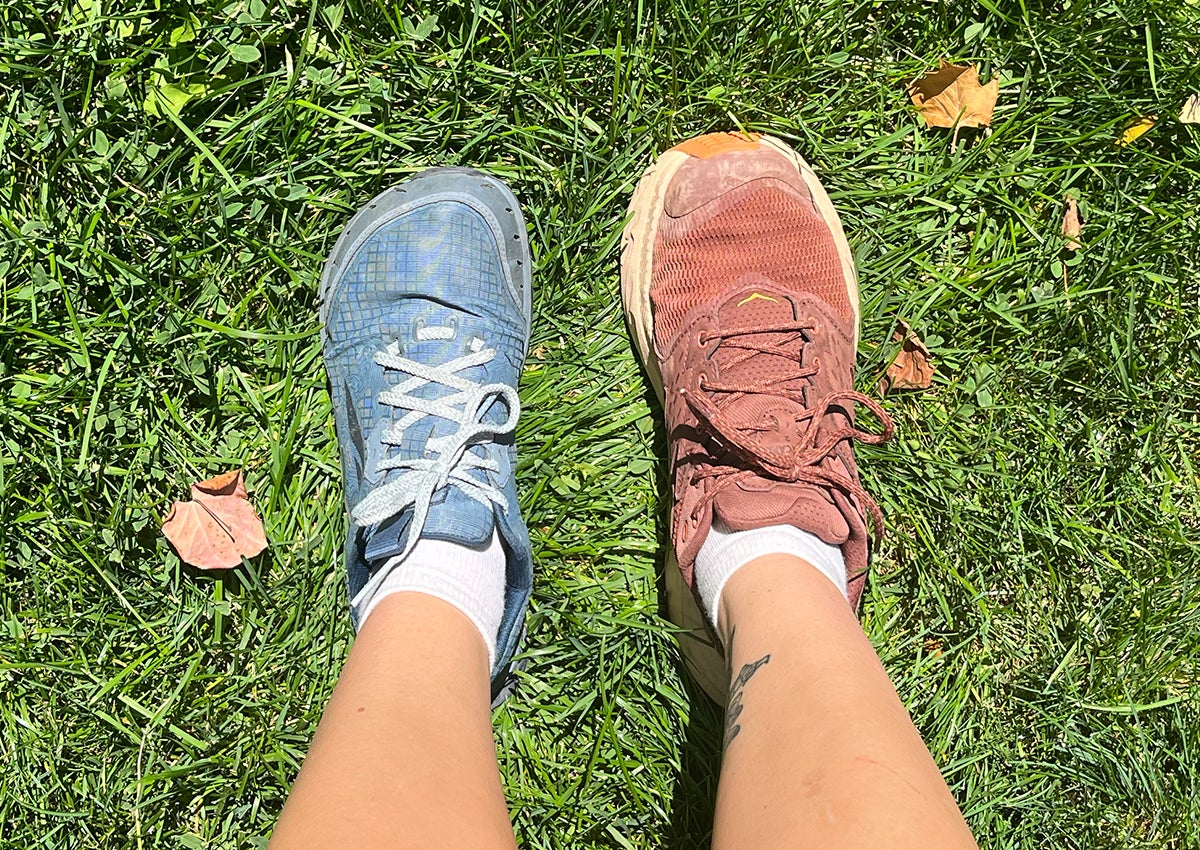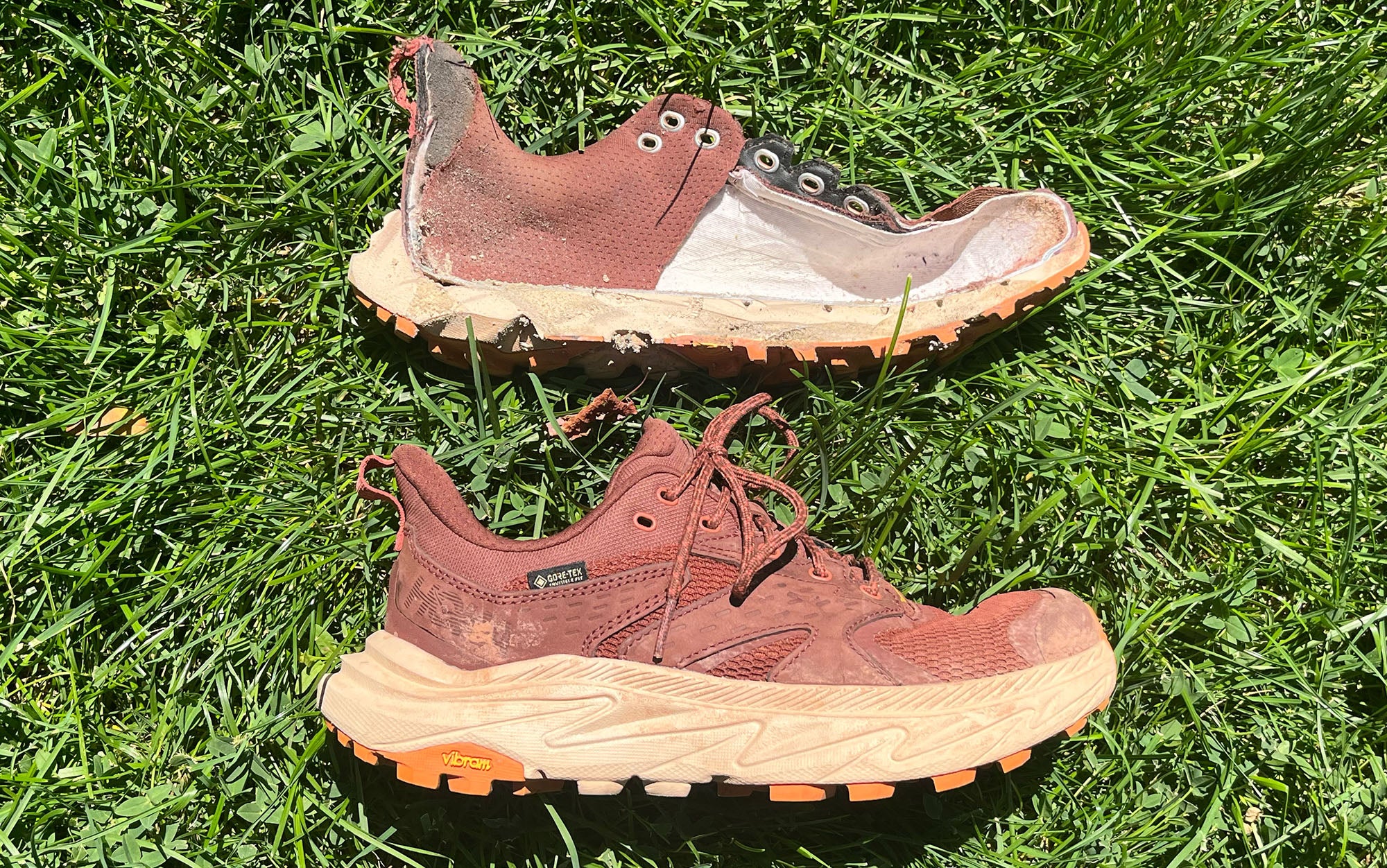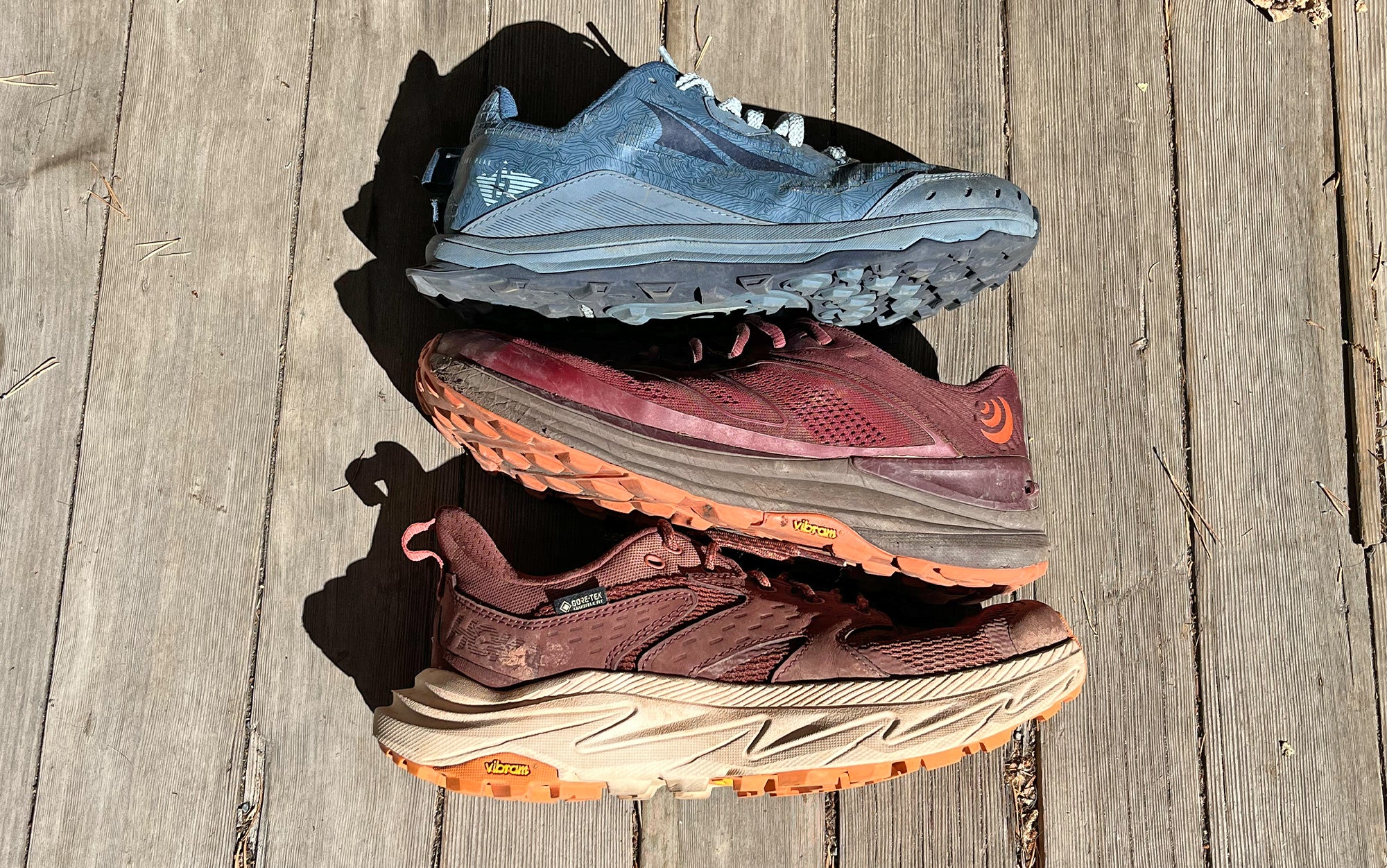Altra vs Hoka: Discover Which Shoe Is Right for You

We may earn revenue from the products available on this page and participate in affiliate programs. Learn More ›
You’d be hard pressed to find a more debated subject in the hiking and trail running world than the relative merits of Altra vs Hoka. Thru-hikers, trail runners, and day hikers alike are dedicated fans of each brand. But here’s the thing: They’re all right. For some people, Altras are the absolute best shoe; for others, it’s Hokas. Below we’ll talk about what each of these shoes is trying to accomplish through their origin stories—they’re very different—before looking at the biomechanical differences between both shoes and how they might interact with your current foot shape, strength, and running style or strike pattern, as well as your needs and desires in the outdoors.
Altra vs Hoka Origin Stories
Hoka’s History
Hoka (which roughly translates to “fly over the earth” in Māori) was founded in 2009 by Nicolas Mermoud and Jean-Luc Diard who wanted to do one thing: run down a mountain as fast as possible without getting hurt. The pair had previously worked with shoemaker Salomon and had a strong grasp on how a new approach to running shoes would help them accomplish their goals. The first step was to increase the cushioning in the shoe, to protect the underfoot from the incessant pounding of going downhill. But increased cushion means a taller, less stable shoe, so they flared the base of the shoe into a wider outsole to increase runners’ confidence with each step and decrease the likelihood of ankle rolls. All while using some of the lightest-weight materials there were. Ultramarathoners loved it.
Altra’s History
Rather than working for a shoe company, Altra founders Brian Beckstead and Golden Harper were working in a shoe store. They were well-versed in the various problems that different runners had with the available shoes on the market, and they eventually decided to get systematic about it. First, “they handed out questionnaires to everyone who was fit at the store,” Alex Lind, Senior Product Line Manager at Altra, told me. “They were able to do a little experiment, collecting data from consumers.” One of the first things they found out while doing this was that, at that time, shoes were not necessarily meant to fit to your feet. This was most evident in the toe box, which was typically so narrow that it was squeezing customers’ toes, not allowing them to splay.
The second thing they noticed while observing customers in the store was that the way people ran without shoes was more natural and efficient than how they ran with shoes. “They wanted to take a step back and see if they could make a more holistic shoe,” said Lind. They started by working with a local cobbler to start selling their own shoes out of their store; no major shoe company would agree to design a shoe with these new ideas. But Beckstead and Harper started mass producing in 2011.
It’s worth noting that the ideas behind Altra were percolating in the late aughts, coincidentally around the same time that Born to Run and the minimalist shoe trends first took off. Lind noted that “a lot of the same ethos is there, but we’re not a minimalist brand by any stretch.”
Altra vs Hoka Practical Differences
While both Hoka and Altra have a number of shoes in their lineups, the Altra Lone Peak and the Hoka Speedgoat (each brand’s most popular models) help illustrate some of the most important differences between the brands’ differing approaches to shoemaking.
Fit

Conventional hiking and running shoes and boots typically work to lock in your foot. The idea is that if it can’t slip and slide around, you’ll be more stable and less likely to roll your ankle or otherwise have sloppy foot placement. While this is most important at the heel, where “locking in” promotes overall stability and reduces ankle rolling, it’s typically seen down the entire length of the foot, including the toes. However, recent years have seen a push toward so-called foot-shaped shoes that allow for toe splay and are comfortable for individuals with less conventional foot shapes.
- Altra Lone Peak: Much wider across the length of the foot, particularly the toebox; no arch support
- Hoka Speedgoat: Wider at the toe box, narrower at heel, midstep, and arch; moderate arch support
“One of the pillars that we stand by is footshape,” said Lind. “It’s allowing room for your toes to splay and spread out and swell and actively work.” The wider toe box of the Altra Lone Peaks were one of the vanguards in a wave of trail runners that now feature wide or very wide toe boxes. What continues to separate the Altra Lone Peak (and the rest of the lineup) from the competition, however, is that the rest of the footbox is also wide. This allows for a couple of things: first, individuals with naturally wider feet, including higher volume feet, typically find that the fit of Altra Lone Peaks is more comfortable.
Thru-hikers have become particularly enamored of this shoe over the years, in large part because it accommodates the foot growth and swell that is common on longer treks. Some people will experience this as their foot sliding around inside of the shoe, however. Because the design of the Altra Lone Peaks are meant to encourage a natural running or hiking gait (particularly a forefoot or midfoot strike), there is no arch support. Instead, individuals who use these shoes typically find over time (sometimes a long time) that their arches strengthen and start to take on some of the shock absorption that the shoe is otherwise missing.
The Hoka Speedgoat was named after Karl “Speedgoat” Meltzer who has won more 100-mile ultramarathons than any other runner. While the Speedgoat does not have as wide a toe box as the Altra Lone Peak, it is still wider than conventional running or hiking shoes, giving you many of the benefits of foot splay. The rest of the shoe is much narrower (the most recent iteration of the Speedgoat is narrower than the earlier iterations were). This will help to lock in the heel and the midstep, promoting stability and helping to prevent ankle rolls, but does not allow for as wide a range of foot shapes as a wider shape throughout the footbox would, or accommodate swelling particularly well.
Stack Height
The stack height of a shoe refers to the measurement between the bottom of the outsole and the top of the midsole—effectively how far off the ground your feet are. Higher stack heights have more cushion in the midsole, and thus protect your feet from both the impact of the ground and the feeling of rocks or other obstacles underfoot. Lower stack height shoes do the opposite. By allowing your foot to experience the differences in terrain underfoot (proprioception in physical therapist-speak), the idea is that your body will naturally adjust your gait and posture in response to minimize injury. Similarly, the sensation of impact underfoot will cause changes in your running style to minimize discomfort from shock absorption.
- Altra Lone Peak: 25mm (forefoot) to 25mm (heel)
- Hoka Speedgoat: 29mm (forefoot) to 33mm (heel)
Hoka Speedgoats have what is considered a high stack height, while Altra Lone Peaks have an average stack height. This is the most important difference between the Altra Lone Peak and a true minimalist shoe: Lone Peaks are cushioning your foot against some of the impact of the ground, and blocking some of the biomechanic feedback that “natural” style runners look for in their shoes. Individuals accustomed to heavily cushioned trail runners or beefy hiking shoes, however, typically experience the Altra Lone Peaks as comparatively low cushion. Conversely, the Hoka Speedgoats are considered some of the most cushioned shoes out there, even though they are on the shorter side of the maximalist stack height range.
Read Next: The Best Thru-Hiking Shoes of 2023
Heel Drop
The heel drop of a shoe is the differential in height between the stack height at the forefoot of the shoe and the stack height at the heel of the shoe. A lot of extra height at the heel provides additional cushioning for heel strikers, helping to absorb some of the additional impact up the leg. A higher drop can also reduce strain on the lower calf muscle and the Achilles tendon. Low stack heights and zero-drop shoes allow forefoot and midfoot strikers to run more naturally.
- Altra Lone Peaks: 0mm
- Hoka Speedgoats: 4mm
Altra does not like to call their shoe zero-drop (even if that’s what it is), but rather, “balanced cushioning.” Generally, zero-drop shoes work best for individuals with a forefoot or midfoot strike; however, some people may have a natural forefoot or midfoot strike and not realize it, due to years or more of wearing traditional running shoes or hiking shoes with a higher heel drop. Lind noted that some of the transition to forefoot or midfoot striking with a zero drop shoe occurs naturally, but that most people will probably have to make a conscious effort to make the switch. Altra recommends giving your feet a few weeks of reduced effort while transitioning, to allow time for your Achilles and calf to stretch and strengthen.
The Hoka Speedgoat heel drop hits a middle ground: high enough that the pressure on your Achilles and calf is reduced, but low enough that it’s not overly disrupting your natural gait.
Outsole

While the majority of reviews focus on the material—typically a rubber compound—the shape of the outsole can have a major impact on both the comfort and the stability of a hiking or running shoe.
- Altra Lone Peak: Standard outsole
- Hoka Speedgoat: Flared outsole with a rocker bottom
While the Altra Lone Peak has an unconventional last, or foot shape, on the interior, the shape of the outsole is decidedly average. It looks and feels like a typical running shoe.

The Hoka Speedgoat, conversely, has a very distinct outsole shape: This is one of the most important attributes of this shoe. The first thing to know is that it is flared, wider at the base than it is at the top of the midsole. This helps some to distribute shock absorption, but more importantly it creates a more stable base for the shoe that offsets the instability caused by its maximalist stack height. Hoka also curves the material of the midsole up around where your foot sits inside the shoe, so that your foot feels cradled. Typically individuals who put on Hokas for the first time express surprise at how stable the shoe is given its stack height.
The Hoka Speedgoat also has a rocker bottom design. This is the distinctive banana shape where the shoe curves up at the back and at the front. There are two advantages to this design. The first is that it lessens the amount you need to bend your ankle or big toe when pushing through a stride, which can be helpful for individuals with tight toes or tight ankles. It also helps, at least in theory, to propel you forward. The idea is that the shape allows your foot to roll through the gait cycle with less interference, reducing the energy you need to put into keeping your momentum going. However, keep in mind that the gait-cyle idea behind the rocker bottom assumes a heel strike and will not have the same biomechanical impact for forefoot or midfoot strikers.
Other Shoes Worth Considering
While the Hoka Speedgoat and the Altra Lone Peak are the most popular shoes in each of these companies’ lineups, there are other models worth looking at, depending on what your specific needs are.
Other Altra Shoes to Consider
- Altra Olympus: 33mm stack height provides more cushioning, although is less responsive
- Altra Superior: 21mm stack height is closer to a true minimalist shoe
Other Hoka Shoes to Consider
- Hoka Torrent: 18mm to 23mm stack height has less cushion and is more responsive
- Hoka Bondi: Considered the most cushioned shoe of any in Altra’s lineup
Other Shoes to Consider

- Topo Ultraventure: A middle ground between the Altra Lone Peak and Hoka Speedgoat
- Brooks Cascadia: A higher heel drop and narrower fit is an easier transition for traditional boot wearers
Read Next: Altra Lone Peak 6 Review: We Put the Best Hiking Shoe to the Test
FAQs
Q: Do Hokas have zero-drop shoes?
No, Hoka does not currently make a shoe that is zero-drop.
Q: Do Altras wear out quickly?
Morgan Brosnihan, a doctor of physical therapy who specializes in thru-hiking, said that the Altra Lone Peaks should be replaced every 300 miles, due to loss of structural support in the shoe.
Q: Are Altras good for bad knees?
Altras, and zero-drop shoes in general, are sometimes good for bad knees. Individuals who are natural midfoot or forefoot strikers may benefit from trying a zero-drop shoe like Altra to see if it alleviates their knee pain.
Q: Who should not wear zero-drop shoes?
Dedicated heel strikers should not wear zero-drop shoes.
Final Thoughts on Altra vs Hoka
If you’re switching from traditional hiking shoes or running shoes to trail runners because you want to go lighter and faster, start with Hokas. But if you’re switching because you want to try tapping into the natural biomechanics of your foot, go with Altras. If you have a narrower foot, try the Hokas first. If you have a wider, larger volume foot, try the Altras first. But really the best way to decide is to go to your local running store and try on both—take both home if you can and wear them out on your typical adventures. “Go with what feels comfortable, listen to your body,” said Lind. “That’s the most important thing.”
The post Altra vs Hoka: Discover Which Shoe Is Right for You appeared first on Outdoor Life.
Articles may contain affiliate links which enable us to share in the revenue of any purchases made.




